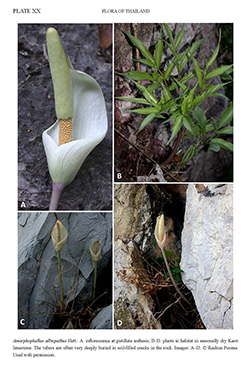e-Flora of Thailand
Volume 11 > Part 2 > Year 2012 > Page 137 > Araceae > Amorphophallus
2. Amorphophallus albispathus Hett.
Blumea 39: 239. 1994. Plate XX.
Accepted Name : This is currently accepted.
Description : Tuber napiform, unbranched (young plants) or with several, parallel, vertical branches, to ca 17 by ca 7 cm. Leaf solitary or two on one tuber; petiole 10–55 cm by 8–18 mm, turgid, smooth, greyish green, the base often with a pinkish or reddish brown hue, or almost entirely pale reddish brown, with or without a few, scattered dark greyish spots; leaf blade moderately dissected, 15–90 cm diam., anterior segment smaller than lateral ones, the latter only in larger leaves subdichotomous; leaflets elliptic, 20–35 by 6–10 cm, long acuminate (acumen ca 3.5 cm long), base long decurrent, subcoriaceous, moderately glossy, greyish green adaxially, paler abaxially. Inflorescence solitary, long pedunculate; peduncle appearance as petiole, ca 40 cm by 9 mm; spathe erect or concave, cymbiform, triangular or triangular-ovate, basal fifth convolute, apex acuminate, 6–14 by 3–10 cm, exterior uniformly pale green or dirty white with scattered pale or dark grey-green punctiform spots and sometimes a very faint, pale purplish hue, interior as exterior, base interior papillate, the basalmost papillae hair-like and often laterally fused and/or with some irregular branches; spadix shorter than spathe, 5–13 cm long, slightly sinuate, sessile; pistillate flower zone slightly conical, 1–2.3 cm by 7–13 mm, flowers congested; ovariesroughly diamond-shaped or somewhat irregular in cross-section, depressed, bright green, 3–4 by ca 2 mm long; style slender, bright green, ca 1 by 0.7–0.8 mm; stigma flattened, 3– or 4-lobed, 1.5–2 mm, dirty white, surface shallowly scabrate-verruculate, lobes subhemispherical; staminate flower zone slightly conical, 1.5–3(–6.5?) cm long, 5–12 mm in diam., flowers congested; staminate flowers consisting of 2–4 (or 5) stamens; stamens with fused filaments, the latter strongly enlarged in the lower flowers, forming a conspicuous, cushion-shaped column 2–3 mm long, turning orange at staminate anthesis; anthers short (ca 1 mm), hemispherical, pale orange-yellow, connective large, helmet-shaped, green, entire anther turning dark orange at anthesis; pores elongate, lateral or rarely subapical; appendix cylindrical-fusiform, smooth with some shallow depressions, ivory-white with a greenish or pink flush, apex and base obtuse, 2–8 cm by 8–20 mm, base with some rounded staminodes. Infructescence elongate, ca 6 cm long and ca 4 cm wide; fruit elongate to ovoid, 1.5–2 by 1–1.5 cm, ripening bright red.
Thailand : SOUTH-WESTERN: Kanchanaburi, Ratchaburi, Prachuap Khiri Khan; SOUTH-EASTERN: Trat; PENINSULAR: Chumphon (type: Bogner 429 cult. sub. Hetterscheid H.AM. 019-T, holotype -L), Phangnga, Nakhon Si Thammarat.
Distribution : Endemic.
Ecology : In humus pockets in limestone in medium deep shade.
Vernacular : Buk (บุก)(Central).
Notes: Amorphophallus albispathus is most similar to A. longituberosus. They share the general inflorescence morphology, the short, hair-like papillae in the spathe base, the large, helmet-shaped connective with lateral pores, the anise-like scent and elongate tuber. However, the leaf blade of A. albispathus is much less strongly divided and the leaflets are much larger, the petiole is much sturdier and the tuber is much shorter and branched.

